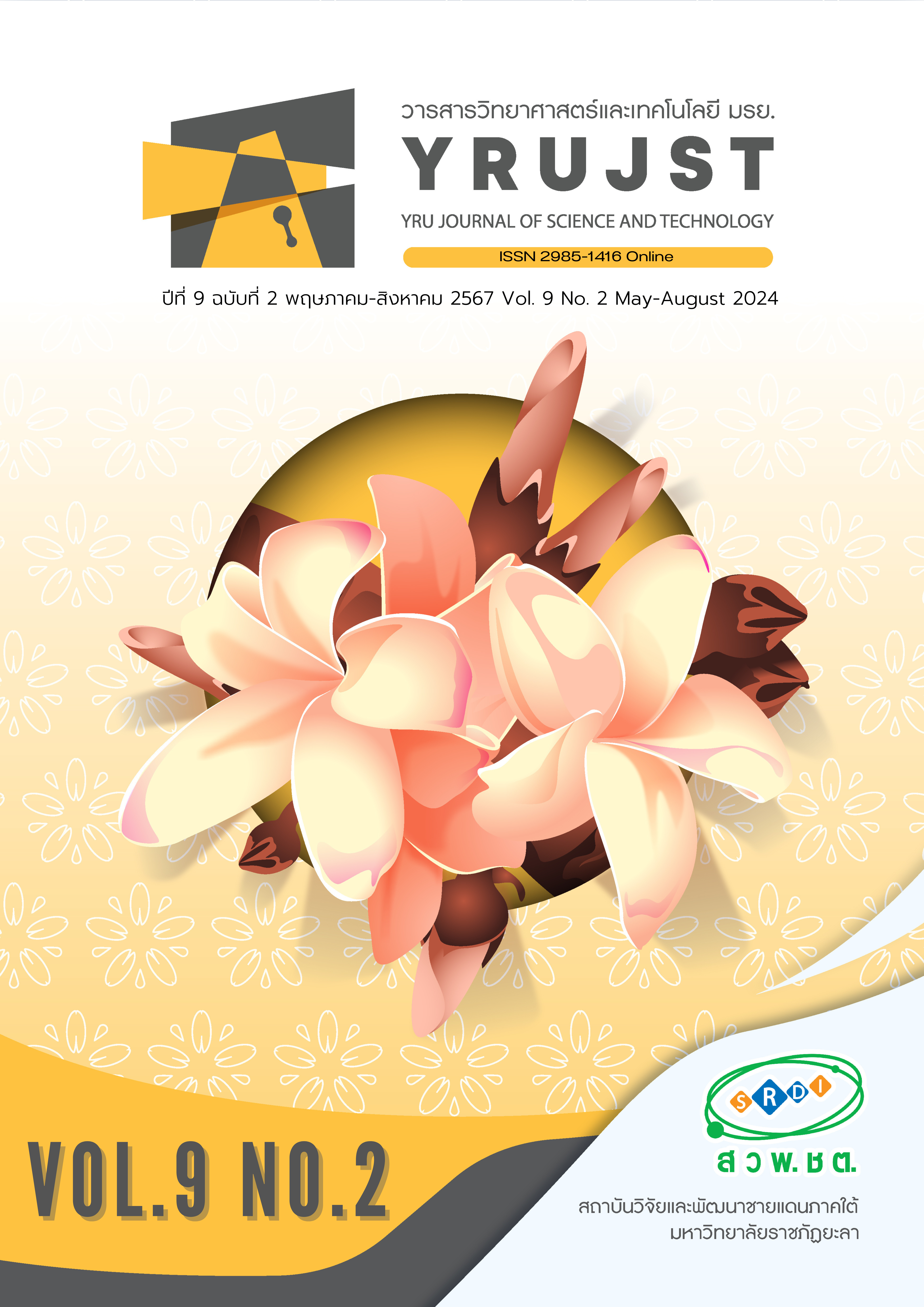การเปรียบเทียบจำนวนทะลายปาล์มน้ำมันพันธุ์การค้าอายุ 10-11 ปีในอำเภอท่าแซะ จังหวัดชุมพร
Main Article Content
บทคัดย่อ
ปัญหาที่มีผลต่อการผลิตปาล์มน้ำมันคือ ความแตกต่างของจำนวนทะลายปาล์มในแต่ละสายพันธุ์ สายพันธุ์ที่มีจำนวนทะลายมากกว่าสามารถผลิตปาล์มน้ำมันในปริมาณมาก เกิดจากความแตกต่างทางพันธุกรรมระหว่างสายพันธุ์ของปาล์มน้ำมัน งานวิจัยนี้มีวัตถุประสงค์เพื่อเปรียบเทียบจำนวนทะลายปาล์มน้ำมันพันธุ์การค้าอายุ 10-11ปี ในปี 2560 และ 2561 วางแผนการทดลองแบบสุ่มอย่างสมบูรณ์ (Completely randomized design, CRD) กำหนดให้สิ่งทดลองคือ พันธุ์ปาล์มน้ำมัน อายุ 10 ปี จำนวน 8 พันธุ์ ได้แก่ สุราษฎร์ธานี 1 สุราษฎร์ธานี 2 สุราษฎร์ธานี 3 สุราษฎร์ธานี 4 สุราษฎร์ธานี 5 สุราษฎร์ธานี 6 เปารงค์ และลาเม่ แต่ละพันธุ์เก็บข้อมูลจำนวนทะลาย จำนวน 10 ต้น ผลการทดลองพบว่า พันธุ์ปาล์มน้ำมันต่างพันธุ์ในปีที่เก็บเกี่ยวผลผลิตต่างกันมีผลทำให้จำนวนทะลายต่อต้นต่อปีต่างกัน เมื่อวิเคราะห์อิทธิพลหลักแบบผลบวก และปฏิกิริยาสัมพันธ์แบบผลคูณ (AMMI) พบว่า การวิเคราะห์องค์ประกอบหลักเพียงหนึ่งแกน (Principal Component Analysis , PCA1) สามารถแยกองค์ประกอบของปฏิสัมพันธ์ระหว่างพันธุ์ปาล์มน้ำมันกับปีที่เก็บเกี่ยวได้ทั้งหมด ตลอดระยะเวลา 2 ปีที่ทำการเก็บข้อมูล ปาล์มน้ำมันพันธุ์สุราษฎร์ธานี 3 มีเสถียรภาพมากที่สุด โดยมีค่า เท่ากับ -0.13 ในส่วนปาล์มน้ำมันพันธุ์ลาเม่ มีเสถียรภาพน้อยที่สุด มีค่า PCA1 เท่ากับ 1.11 เมื่อพิจารณาการปรับตัวเฉพาะพบว่า ปาล์มน้ำมันพันธุ์สุราษฎร์ธานี 6 ให้จำนวนทะลายต่อปีได้มากที่สุด เท่ากับ 18.30 ทะลาย ในขณะที่ปีพ.ศ.2560 ปาล์มน้ำมันพันธุ์สุราษฎร์ธานี 5 ให้จำนวนทะลายต่อปีได้มากที่สุด ในปีพ.ศ.2561 เท่ากับ 15.10 ทะลาย ดังนั้นพันธุ์ปาล์มน้ำมันที่ควรเลือกปลูก คือ พันธุ์สุราษฎร์ธานี 3 5 และ 6 ซึ่งสภาพแวดล้อมที่เหมาะสม ต้องมีการกระจายของน้ำฝนสม่ำเสมอ
Article Details

อนุญาตภายใต้เงื่อนไข Creative Commons Attribution-NonCommercial-NoDerivatives 4.0 International License.
บทความ ข้อมูล เนื้อหา รูปภาพ ฯลฯ ที่ได้รับการเผยแพร่ในวารสารวิทยาศาสตร์และเทคโนโลยี มรย. นี้ ถือเป็นลิขสิทธิ์ของวารสารวิทยาศาสตร์และเทคโนโลยี มรย. หากบุคคลหรือหน่วยงานใดต้องการนำทั้งหมดหรือส่วนหนึ่งส่วนใดไปเผยแพร่ต่อหรือกระทำการใดๆ จะต้องได้รับอนุญาตเป็นลายลักษณ์อักษรจากวารสารวิทยาศาสตร์และเทคโนโลยี มรย. ก่อนเท่านั้น
เอกสารอ้างอิง
Centre for Agricultural Information. (2023). Statistics agricultural of thailand 2012. Bangkok: Office of Agricultural Economics, Ministry of Agriculture and Cooperatives.
Corley, R.H.V. & Tinker, P.B. (2003). The Oil Palm. Oxford: Blackwell Science Ltd.
Falconer, D.S. (1981). Introduction to quantitative genetics. New York: Longman.
Eaksomtramate, T. (2011). Oil Palm Breeding. Bangkok: OS Printing House Co., Ltd.
Gauch, H.G. (1988). Model selection and validation for yield trials with interaction. Biometrics, 44, 705 – 715.
Gauch, H.G. (1992). Statistical analysis of regional yield trials: AMMI analysis of factorial designs. Amsterdam: Elsevier Science Publisher B.V.
Li-Hammeda, M.A., Kushairi, A.D. & Rajanaidu, N. (2016). Genetic variability for yield, yield components and fatty acid traits in oil palm (Elaeis guineensis Jacq.) germplasm using multivariate tools. International Journal of Plant Science, 2, 219-226.
Office of Agricultural Economics. (2022). Situations and trends of important agricultural products in 2013. Bangkok: Office of Agricultural Economics, Ministry of Agriculture and Cooperatives.
Rungnilrat, T., Kaewpradap, T., Thepbutr, P., Khangkhamani, T. & Eaksomtramet, T. (2023). Growth and the correlation between product characteristics output element and oil yield of commercial varieties of oil palm. Journal of Agricultural Research and Extension, 40(1), 28-39.
Thailand Professional Qualification Institute. (2021). Professional qualification and occupational standards Agricultural professions; economic crops; Occupation of oil palm worker. Bangkok: Thailand Professional Qualification Institute.
Samphantharak, K. (2008). Plant breeding: basics, methods and concepts. Bangkok: Extension and Training Office, Kasetsart University.


